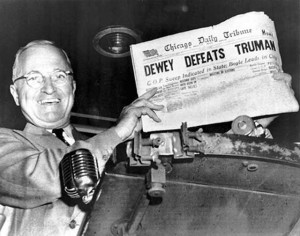
Deadlines are always a problem, as this legendary photo reminds us. But in today's 24/7 news business, there's less and less incentive to divine the difference between wild rumor and solid news.
There’s a rampant prairie fire blazing in the automotive media, and its swept from Detroit throughout the rest of the world.
There’s no surprise, considering the current crisis, that even the most mainstream publishers are looking to break news about the fate of General Motors, Chrysler and the rest of the troubled auto industry. Everywhere you turn, in print or online, headlines tout the latest stories. Or should I correct that and say they blare the latest rumors and innuendos.
“Chrysler’s Unions Won’t Budge,” begins one report. “A Deal With The Canadian Union is Near,” counters another. “Fiat Ready to Walk From Chrysler,” declares a third, while others insist Fiat’s CEO, Sergio Marchione, is more committed than ever to doing a deal with the U.S. maker – often citing the CEO’s own comments to prove their point. Still others chime in that the Italian exec is also ready to buy a small/major/controlling stake in GM’s troubled European subsidiary, Opel.
Friday’s rumor du jour concerned the Pontiac division, which GM has pledged to downsize into a niche operation. Not good enough, says the White House, insisting Pontiac must be shuttered entirely. At least that’s what the rumor mill is churning out. Never mind GM’s denials. What matters, right now, is all about making the most memorable headlines. They’re coming so fast and furious, it seems to be irrelevant whether the stories are right or wrong. There are so many, after all, the public likely won’t remember who hit the mark and which media outlets are shooting blanks.
In a sense, what we’re reading says as much or more about another seriously troubled industry: the news business.
Ah, yes, there’s “that” headline, “Newspapers are dying,” and desperate to do anything they can to attract readers. The flip side is the inherent demands placed upon the electronic media: the 30-minutes cycles of headline TV and the voracious 24/7 appetite of the Internet.
To be fair, TheDetroitBureau.com is playing in this world. We’re trying to maintain a semblance of balance and skepticism before we add our own banner type to the digital tear sheets. But it’s not easy, right now, discerning the difference between wild rumors and source reports that are heavily fact based. So, even the best players are getting some of the stories wrong.
One reason is that the heavy hitters in the automotive world are playing for keeps, right now. The strategies they choose will likely make or break some of the industry’s most established players, and not just troubled General Motors and Chrysler. The game is complicated by the participation of the Obama White House, which will not only have the last word when it comes to the survival of GM and Chrysler, but will influence the shape of the global car business for decades to come. So, what’s going on now has as much to do with politics as it does with boardrooms and bargaining tables.
Translation: much of the negotiating, right now, is taking place in the media, much as it does when Washington works on the federal budget.
So, it’s not surprising that those oft-quotes “sources” are whispering lots of things into the collective media ear, right now. A hungry media. One that is shorter on manpower than ever, and one that often is letting time constraints and competitive pressures overwhelm the normal due diligence we were taught in Journalism School.
Caveat emptor – buyer beware – is a sound guideline when you’re looking to buy a car. Reader beware is an equally good warning as you peruse the latest breaking news. The truth is likely in there, somewhere, but in my 30 years of covering the auto industry, I can’t remember seeing the rush to be the first with the latest so overwhelm the need to ensure accuracy and informative debate.

Important observations! Your diligent journalism is appreciated… keep up the good work!
Jack Harned